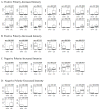Developmental cigarette smoke exposure: hippocampus proteome and metabolome profiles in low birth weight pups
- PMID: 24486158
- PMCID: PMC4067966
- DOI: 10.1016/j.tox.2014.01.006
Developmental cigarette smoke exposure: hippocampus proteome and metabolome profiles in low birth weight pups
Abstract
Exposure to cigarette smoke during development is linked to neurodevelopmental delays and cognitive impairment including impulsivity, attention deficit disorder, and lower IQ. However, brain region specific biomolecular alterations induced by developmental cigarette smoke exposure (CSE) remain largely unexplored. In the current molecular phenotyping study, a mouse model of 'active' developmental CSE (serum cotinine > 50 ng/mL) spanning pre-implantation through third trimester-equivalent brain development (gestational day (GD) 1 through postnatal day (PD) 21) was utilized. Hippocampus tissue collected at the time of cessation of exposure was processed for gel-based proteomic and non-targeted metabolomic profiling with partial least squares-discriminant analysis (PLS-DA) for selection of features of interest. Ingenuity pathway analysis was utilized to identify candidate molecular and metabolic pathways impacted within the hippocampus. CSE impacted glycolysis, oxidative phosphorylation, fatty acid metabolism, and neurodevelopment pathways within the developing hippocampus.
Keywords: Cigarette smoke; Development; Hippocampus; Metabolome; Proteome; Tobacco.
Copyright © 2014 Elsevier Ireland Ltd. All rights reserved.
Figures







Similar articles
-
Developmental cigarette smoke exposure II: Hepatic proteome profiles in 6 month old adult offspring.Reprod Toxicol. 2016 Oct;65:414-424. doi: 10.1016/j.reprotox.2016.06.009. Epub 2016 Jun 16. Reprod Toxicol. 2016. PMID: 27319396 Free PMC article.
-
Developmental cigarette smoke exposure: kidney proteome profile alterations in low birth weight pups.Toxicology. 2012 Sep 28;299(2-3):80-9. doi: 10.1016/j.tox.2012.04.015. Epub 2012 May 15. Toxicology. 2012. PMID: 22595367 Free PMC article.
-
Developmental cigarette smoke exposure II: Hippocampus proteome and metabolome profiles in adult offspring.Reprod Toxicol. 2016 Oct;65:436-447. doi: 10.1016/j.reprotox.2016.05.007. Epub 2016 May 18. Reprod Toxicol. 2016. PMID: 27208486 Free PMC article.
-
Developmental cigarette smoke exposure: liver proteome profile alterations in low birth weight pups.Toxicology. 2012 Oct 9;300(1-2):1-11. doi: 10.1016/j.tox.2012.04.016. Epub 2012 May 15. Toxicology. 2012. PMID: 22609517 Free PMC article.
-
Maternal smoking as a model for environmental epigenetic changes affecting birthweight and fetal programming.Mol Hum Reprod. 2013 Jan;19(1):1-6. doi: 10.1093/molehr/gas050. Epub 2012 Nov 8. Mol Hum Reprod. 2013. PMID: 23139402 Free PMC article. Review.
Cited by
-
Nucleus Accumbens Proteome Disbalance in an Adolescent Mouse Model of Schizophrenia and Nicotine Misuse Comorbidity.Biomedicines. 2025 Apr 8;13(4):901. doi: 10.3390/biomedicines13040901. Biomedicines. 2025. PMID: 40299488 Free PMC article.
-
Prenatal nicotine exposure decreases the release of dopamine in the medial frontal cortex and induces atomoxetine-responsive neurobehavioral deficits in mice.Psychopharmacology (Berl). 2017 Jun;234(12):1853-1869. doi: 10.1007/s00213-017-4591-z. Epub 2017 Mar 23. Psychopharmacology (Berl). 2017. PMID: 28332006
-
Developmental cigarette smoke exposure II: Hepatic proteome profiles in 6 month old adult offspring.Reprod Toxicol. 2016 Oct;65:414-424. doi: 10.1016/j.reprotox.2016.06.009. Epub 2016 Jun 16. Reprod Toxicol. 2016. PMID: 27319396 Free PMC article.
-
Developmental cigarette smoke exposure II: Kidney proteome profile alterations in 6 month old adult offspring.Reprod Toxicol. 2016 Oct;65:425-435. doi: 10.1016/j.reprotox.2016.05.008. Epub 2016 May 18. Reprod Toxicol. 2016. PMID: 27208485 Free PMC article.
-
Metabolomic similarities between bronchoalveolar lavage fluid and plasma in humans and mice.Sci Rep. 2017 Jul 11;7(1):5108. doi: 10.1038/s41598-017-05374-1. Sci Rep. 2017. PMID: 28698669 Free PMC article.
References
-
- 2012 Current cigarette smoking among adults - United States. MMWR Morb Mortal Wkly Rep. 2011;61:889–894. - PubMed
-
- Abel EL. Smoking during pregnancy: a review of effects on growth and development of offspring. Hum Biol. 1980;52:593–625. - PubMed
-
- Ajarem JS, Ahmad M. Prenatal nicotine exposure modifies behavior of mice through early development. Pharmacol Biochem Behav. 1998;59:313–318. - PubMed
-
- Arnold SE, Trojanowski JQ. Human fetal hippocampal development: I. Cytoarchitecture, myeloarchitecture, and neuronal morphologic features. J Comp Neurol. 1996a;367:274–292. - PubMed
Publication types
MeSH terms
Substances
Grants and funding
LinkOut - more resources
Full Text Sources
Other Literature Sources
Medical

